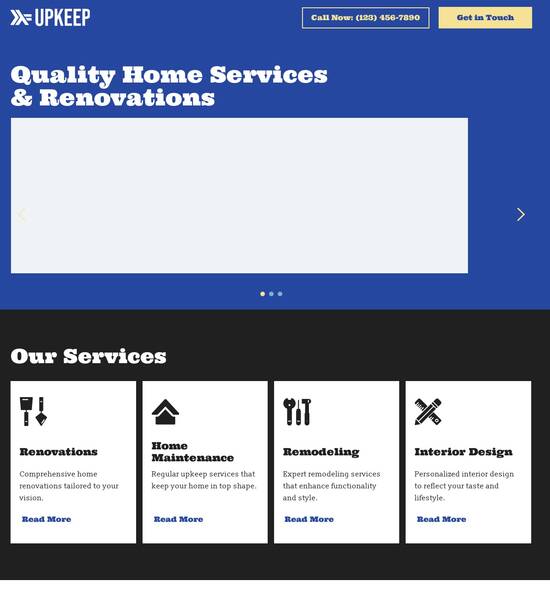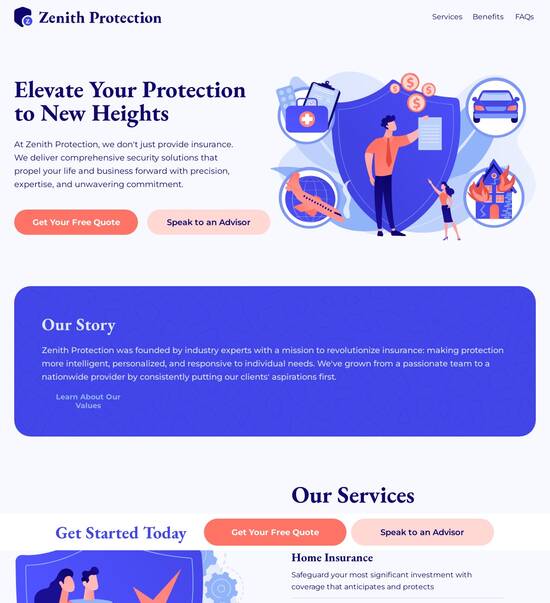
Lead generation page template for Node.js developers
Explore Similar TemplatesAbout template
Master your online marketing with this builder for lead generation page template for Node.js developers. Try more tools to create an immaculate landing page.
Recommended templates

Easy to build without coding
With the intuitive drag-and-drop builder, anyone on your team can create high-converting pages without any knowledge of code or design. Make enhancements to your landing page with custom widgets using Javascript, HTML/CSS, or third-party scripts.

Multiple layouts for any industry and goal
Select from 500+ landing page layouts built to boost conversions across industry-specific scenarios. Customize them by adjusting fonts, adding images, and generating on-brand content with the AI assistant. Quickly scale with Instablocks® and Global Blocks that you can save, reuse, and update globally.

Loads fast and looks polished on any device
Every template is responsive, which means they present professionally on any device and load blazingly fast with our Thor Render Engine. You can also power them up with Google AMP technology to deliver an unparalleled mobile experience and drive higher conversions.

Robust analytics & experimentation
Get real-time updates and reporting across all your devices, showing the number of visitors, conversions, cost-per-visitor, and cost-per-lead. Launch AI-powered experiments, run A/B tests, and use heatmaps to analyze user behavior, then optimize your landing page to maximize conversions.







Easy to build without coding
With the intuitive drag-and-drop builder, anyone on your team can create high-converting pages without any knowledge of code or design. Make enhancements to your landing page with custom widgets using Javascript, HTML/CSS, or third-party scripts.
Multiple layouts for any industry and goal
Select from 500+ landing page layouts built to boost conversions across industry-specific scenarios. Customize them by adjusting fonts, adding images, and generating on-brand content with the AI assistant. Quickly scale with Instablocks® and Global Blocks that you can save, reuse, and update globally.
Loads fast and looks polished on any device
Every template is responsive, which means they present professionally on any device and load blazingly fast with our Thor Render Engine.
Robust analytics & experimentation
Get real-time updates and reporting across all your devices, showing the number of visitors, conversions, cost-per-visitor, and cost-per-lead. Launch AI-powered experiments, run A/B tests, and use heatmaps to analyze user behavior, then optimize your landing page to maximize conversions.
All the features you need to build lead-generating landing pages
Explore more featuresLearn how to build top-performing landing pages for any goal
FAQs
Leading the way in building high-performing landing pages





A step-by-step guide to creating effective lead generation pages for marketers
Creating effective lead generation pages is essential for marketers looking to accelerate their campaigns and maximize ROI. Instapage's powerful landing page platform allows teams of any size to craft pages that not only attract visitors but also convert them into leads. Whether you're in business services, tech, or education, this guide offers a clear roadmap to build lead-generation pages that are not just visually appealing but also optimized for conversion success.
Understanding the importance of lead generation pages
Lead generation pages serve as key touchpoints in a marketing strategy, converting visitors into potential customers. They focus on a single offer, making it essential to capture interest effectively. Using Instapage, marketers can create customized pages aligned with their audiences for better engagement.
- Focused Content: Concentrating on a single offer can increase conversion rates.
- Clear Call to Action: Ensuring the CTA is visible and compelling helps guide users.
- Visual Appeal: Utilizing high-quality images and a clean layout maintains user interest.
Step 1: Choose your template
Start by selecting a template that resonates with your target audience and aligns with your marketing goals. Instapage offers over 100 high-converting templates that require no coding knowledge to implement. Choose one that fits your specific needs, whether you are targeting tech-savvy individuals or professionals in finance.
Step 2: Customize the content
Tailor the selected template to fit your brand's message. This may include adjusting text, colors, and images. Important elements like dynamic text replacement can help personalize content for unique audiences.
- Brand Consistency: Use your brand colors and fonts to create familiarity.
- Targeted Messaging: Adapt your message based on the audience segment.
- Dynamic Elements: Consider adding timers or limited-time offers to create urgency.
Step 3: Optimize for conversion
Once your page is set up, use Instapage's built-in optimization tools to maximize conversions. A/B testing tools allow for testing different headlines or CTAs to see which performs better amongst your audience. Utilize heatmaps to analyze user interaction and make adjustments based on this data.
- A/B Testing: Test variations of your landing page to find the best-performing version.
- Heatmaps: Identify where users click to improve design and layout.
- Analytics Dashboard: Monitor real-time results to track your page's performance.
By following these steps, you can build and optimize lead generation pages that drive results for your marketing campaigns.
Ready to enhance your marketing efforts? Start building high-converting lead generation pages with Instapage today and watch your ROI soar!
People also ask about Lead generation page template for Node.js developers
Unveiling the Power of Lead Generation Page Templates for Node.js Developers
Understanding the landscape of lead generation
Lead generation is essential in the current online market, serving as the process of identifying and attracting potential customers. It not only allows businesses to build a customer base but also helps them engage and nurture leads to convert them into paying customers. Key statistics indicate rapid growth in online lead generation strategies, highlighting that companies utilizing landing pages see conversion rates of up to 300% higher than those who do not. This shift emphasizes the critical nature of efficient lead generation in today's business landscape.
Landing pages play a pivotal role in lead generation by converting site visitors into prospective leads. A well-structured landing page focuses on a single objective that aligns with the overarching goals of a marketing campaign—whether to collect emails, promote a product, or drive downloads. The alignment between design elements and content is crucial; mismatched components can confuse and alienate potential leads.
Node.js: a preferred choice for web development
Node.js has emerged as a preferred technology for web development, especially for building high-performance applications. One of its defining characteristics is an event-driven architecture that supports non-blocking I/O operations. This approach enhances scalability, allowing developers to handle multiple connections simultaneously without a significant decrease in performance. Furthermore, Node.js boasts a rich ecosystem, with the npm repository providing an extensive array of packages and libraries that streamline development and enhance functionality.
For lead generation pages, Node.js is particularly advantageous due to its flexibility in managing data flow between client and server. This capability enables developers to create responsive, real-time applications that can adjust to user interactions dynamically. As a result, developers can build engaging lead generation pages that hold users’ interest and encourage conversions.
Crafting the perfect lead generation page template
To create a high-converting lead generation page, several essential elements must be present. Eye-catching headlines paired with persuasive content can immediately grab the attention of visitors. Utilizing clear and enticing calls to action (CTAs) can significantly boost engagement and conversions; CTAs should be visible and compelling, guiding users towards the desired action. Additionally, form placement is vital; forms should be easily accessible, and their usability should be optimized to minimize friction during the data entry process.
Template engines facilitate the development of landing pages by allowing developers to reuse code, manage layouts, and efficiently render dynamic content. EJS and Pug are two popular template engines used in the Node.js environment. Both engines provide distinct approaches to rendering logic and syntax, which can streamline the development of lead generation pages and enhance overall productivity.
Diving into template engines: EJS vs. Pug
EJS (Embedded JavaScript) is known for its simplicity and widespread familiarity among developers. Its straightforward syntax allows easy integration of dynamic data into HTML. EJS supports use cases in lead generation pages, offering features like partials and layouts that facilitate the development process. For instance, using EJS, developers can render dynamic forms based on user input, enhancing overall user experience and engagement.
Dynamic content rendering using EJS templates.
Partial views to maintain reusable components across pages.
Easy integration with the Express framework for routing and middleware.
Pug, on the other hand, offers a clean, whitespace-sensitive syntax that promotes enhanced readability. Its unique features, such as mixins and conditionals, allow for efficient coding without compromising functionality. Pug’s use of indentation can significantly reduce the amount of syntax code required, speeding up the development process for lead generation pages, especially for those with complex layouts.
Implementing logic in lead generation templates
Structuring your application with robust logic is crucial for effective lead generation. It is vital to plan the data flow and application logic meticulously. Middleware functions facilitate the handling of form submissions and ensure that data flows seamlessly between the client and server. With Node.js, developers can leverage middleware to perform validations, execute business logic, and handle errors effectively.
Handling user inputs and storing data should be approached carefully to maintain a high-quality user experience. Employing validation techniques such as regular expressions and libraries like validator.js helps ensure that data is structured correctly and meets necessary criteria. Additionally, integrating with databases such as MongoDB or PostgreSQL for data persistence allows for effective lead management and retrieval.
Designing engaging & responsive lead generation pages
Design best practices are critical in creating lead generation pages that engage users. Prioritizing a mobile-first design ensures that pages render well across various devices, providing a smooth user experience. Accessibility must not be overlooked either; adhering to WCAG (Web Content Accessibility Guidelines) makes pages usable for a broader audience, ensuring that potential leads can interact with your content regardless of ability.
Utilizing responsive frameworks such as Bootstrap or Tailwind CSS for flexible designs.
Incorporating client-side JavaScript to enhance user interactions.
Ensuring fast load times through optimized assets and minimal HTTP requests.
Moreover, utilizing CSS frameworks helps align aesthetics with functionality, allowing for styles that both attract and convert visitors. Meanwhile, JavaScript libraries, such as jQuery or React, can introduce dynamic elements to landing pages, enhancing their interactivity and user engagement, which is essential for driving conversions.
Testing and optimizing your lead generation page
Implementing A/B testing is a critical aspect of optimizing landing pages. By creating variations of your page and measuring success metrics—such as conversion rates and user engagement—you can uncover insights into what resonates best with your audience. Tools like Google Optimize or Optimizely can facilitate this process, providing data-driven results that inform decisions.
Analyzing user behavior is essential for refining lead generation strategies. Utilizing analytics tools like Google Analytics provides a wealth of information about user interactions, allowing you to track performance metrics such as bounce rates and session duration. Key metrics to focus on include conversion rates, click-through rates, and user retention—data that can guide iterative improvements.
Case studies: success stories
Examining real-world examples of effective Node.js lead generation pages offers valuable insights. Organizations that effectively incorporate Node.js into their lead generation strategy often highlight streamlined user experiences and higher conversion rates. For instance, several SaaS companies have successfully implemented interactive landing pages with real-time data handling, leading to increased engagement and lead capture.
A notable project where real-time analytics were displayed, enhancing user interaction.
Implementation of personalized content based on user behavior metrics, leading to increased conversion rates.
Continuous engagement through targeted follow-up campaigns post-lead capture.
These case studies underline the importance of innovative thinking and adaptation in today's competitive landscape. By integrating effective lead generation strategies with Node.js, developers can create solutions that not only attract leads but also convert them into loyal customers.
Future trends in lead generation with Node.js
As technology evolves, the impact of machine learning and AI on lead generation continues to grow. Personalizing user experiences using AI can significantly enhance engagement on landing pages by tailoring content to individual preferences. Furthermore, predictive analytics can help identify potential high-value leads, enabling marketers to focus their efforts where they are most likely to yield results.
Moreover, with increasing data privacy concerns, navigating regulations such as GDPR is vital for successful lead generation strategies. Organizations must prioritize ethical data collection practices, ensuring transparency and consent. Implementing robust privacy measures not only helps in compliance but also fosters trust, enhancing brand reputation in the competitive landscape.
Engaging with the community: sharing knowledge
The Node.js community thrives on collaboration, with opportunities to contribute to open-source projects providing benefits for both developers and the wider ecosystem. Sharing lead generation templates can enhance the capabilities of peers, while also allowing developers to receive feedback and improve their work. Platforms like GitHub and Codecademy are excellent for collaboration and learning.
Staying updated with trends and techniques is crucial in this ever-evolving field. Following relevant newsletters, participating in community forums, and engaging with platforms focused on Node.js development can keep marketers and developers informed. This engagement is not only beneficial for professional growth but can also inspire innovative ideas for lead generation strategies.
Ready to skyrocket conversions?
Supercharge your ad campaigns with high-performing landing pages
Get started














